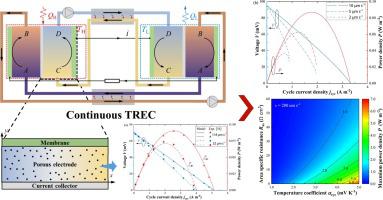Energy Conversion and Management ( IF 9.9 ) Pub Date : 2022-11-16 , DOI: 10.1016/j.enconman.2022.116438 Ruihua Chen , Shuai Deng , Li Zhao , Weicong Xu , Ruikai Zhao

|
Continuous thermally regenerative electrochemical cycle (TREC), which could convert heat to power and realize the continuous power output, is a promising technology for low-grade heat harvesting. However, the mechanism elucidation and performance analysis of continuous TREC are still incomplete, which hinders its performance improvement and practical applications. In this study, a pseudo-two-dimensional flow and electrochemical coupled model for continuous TREC is developed to investigate its performance. Based on the model, the polarization mechanism is revealed, and the effects of operating parameters and physical properties of electrolytes on the cycle performance are analyzed in detail. The results indicate that the concentration polarization is the major contributor to the system overpotential, especially at low electrolyte flow velocities. Regarding operating parameters, although temperatures of heat source and heat sink and electrolyte flow velocity determine the power density, the heat recuperation efficiency shows a decisive effect on the efficiencies. With perfect recuperation, the thermal efficiency and exergy efficiency could reach 8.3 % and 57.5 %, respectively. Regarding physical properties of electrolytes, the electrolyte concentrations affect the power density by changing the limiting current density. In addition, the temperature coefficient significantly affects the power density at any electrolyte flow velocity, while the internal resistance does so only at high flow velocities. With a temperature difference of 50 °C, a high power density of 4.33 W m−2 is expected if the temperature coefficient is increased to 4.0 mV K−1 and the area specific resistance is reduced to 1.0 Ω cm2. Based on the results, beneficial recommendations are put forward for further optimizing the system configuration and screening electrolytes for continuous TREC.
中文翻译:

迈向高效的连续热再生电化学循环:基于模型的性能图和分析
连续热再生电化学循环(TREC)可以将热能转化为电能并实现连续功率输出,是一种很有前途的低品位热收集技术。然而,连续TREC的机理阐明和性能分析尚不完善,阻碍了其性能的提升和实际应用。在这项研究中,开发了连续 TREC 的伪二维流动和电化学耦合模型以研究其性能。基于该模型,揭示了极化机理,并详细分析了电解质的运行参数和物理性质对循环性能的影响。结果表明浓差极化是系统过电势的主要原因,尤其是在低电解液流速下。关于运行参数,虽然热源和散热器的温度以及电解液流速决定了功率密度,但热回收效率对效率具有决定性影响。通过完美的换热,热效率和火用效率可分别达到 8.3% 和 57.5%。关于电解质的物理性质,电解质浓度通过改变极限电流密度来影响功率密度。此外,温度系数显着影响任何电解液流速下的功率密度,而内阻仅在高流速下才会影响。温差50℃,功率密度高4.33W·m 尽管热源和散热器的温度以及电解液流速决定了功率密度,但热回收效率对效率具有决定性影响。通过完美的换热,热效率和火用效率可分别达到 8.3% 和 57.5%。关于电解质的物理性质,电解质浓度通过改变极限电流密度来影响功率密度。此外,温度系数显着影响任何电解液流速下的功率密度,而内阻仅在高流速下才会影响。温差50℃,功率密度高4.33W·m 尽管热源和散热器的温度以及电解液流速决定了功率密度,但热回收效率对效率具有决定性影响。通过完美的换热,热效率和火用效率可分别达到 8.3% 和 57.5%。关于电解质的物理性质,电解质浓度通过改变极限电流密度来影响功率密度。此外,温度系数显着影响任何电解液流速下的功率密度,而内阻仅在高流速下才会影响。温差50℃,功率密度高4.33W·m 热效率和火用效率分别达到8.3%和57.5%。关于电解质的物理性质,电解质浓度通过改变极限电流密度来影响功率密度。此外,温度系数显着影响任何电解液流速下的功率密度,而内阻仅在高流速下才会影响。温差50℃,功率密度高4.33W·m 热效率和火用效率分别达到8.3%和57.5%。关于电解质的物理性质,电解质浓度通过改变极限电流密度来影响功率密度。此外,温度系数显着影响任何电解液流速下的功率密度,而内阻仅在高流速下才会影响。温差50℃,功率密度高4.33W·m 而内部阻力仅在高流速下起作用。温差50℃,功率密度高4.33W·m 而内部阻力仅在高流速下起作用。温差50℃,功率密度高4.33W·m如果温度系数增加到 4.0 mV K −1并且面积比电阻减小到 1.0 Ω cm 2 ,则预期为-2。基于研究结果,为进一步优化连续TREC的系统配置和筛选电解质提出了有益的建议。










































 京公网安备 11010802027423号
京公网安备 11010802027423号